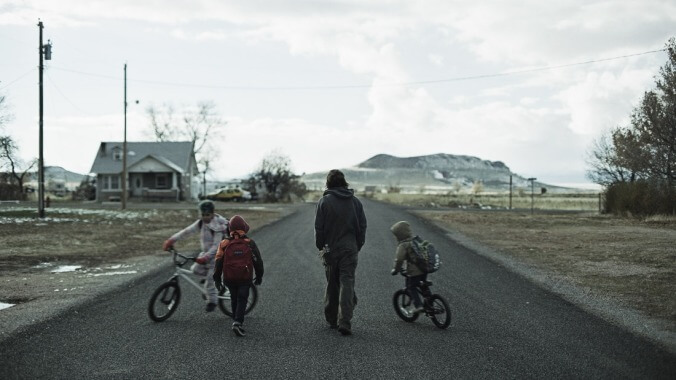Potential violence haunts every frame of the superb Killing Of Two Lovers
An initial, alarming threat winds up subsumed by the mundane sorrows and frustrations of a fractured family in Robert Machoian's film

Note: The writer of this review watched The Killing Of Two Lovers on a digital screener from home. Before making the decision to see it—or any other film—in a movie theater, please consider the health risks involved. Here’s an interview on the matter with scientific experts.
Hitchcock’s famous example of suspense—a bomb planted beneath a table, its presence known to the viewer but not to the characters on screen—works equally well if the explosive device is a human being. In The Killing Of Two Lovers, it’s a middle-aged man named David (Clayne Crawford) who’s silently ticking; the film opens with him standing over the bed of a sleeping couple, pointing a pistol at each of them in turn, visibly anguished. Before he can summon the nerve or the will or the evil to fire, a toilet flushed elsewhere in the house scares him off, out the window and down the street, on foot, to what’s eventually revealed as his childhood home, where he’s temporarily moved back in with his widowed father (Bruce Graham). The woman David pondered murdering turns out to be his wife, Nikki (Sepideh Moafi), with whom he has a teenage daughter (Avery Pizzuto) and three younger sons (Arri, Ezra, and Jonah Graham). They’re recently separated, and both theoretically free to date others. David’s not handling it very well.
What makes The Killing Of Two Lovers more than just another tale of toxic testosterone is the extent to which this initial, alarming threat winds up subsumed by the mundane sorrows and frustrations of a fractured family. The specter of potential violence haunts everything that follows, with recurring reminders in the form of David’s actions—he stalks Derek (Chris Coy), the man Nikki has taken up with—and bursts of aggressively dissonant sound design that suggest a hair-trigger mental state. At the same time, though, David also just goes about the business of trying to get his life back in order. He dotes on their kids, walking the boys to school in the morning and struggling to explain the complexities of adult relationships to his wounded and angry daughter. Direct interactions with Nikki betray no hint of rancor; they go out on a scheduled date night, wind up parked not far from their house to make sure the kids are okay, and actually laugh together when Derek shows up at the door with a bouquet of flowers, which the boys promptly take outside and rip to shreds. (“Bury the evidence!”) Remove just a few admittedly crucial minutes from the film’s first hour and it would still be a superlative portrait of a painful split, evocatively shot in the squarish Academy ratio and rooted in achingly recognizable confusion and consternation.
Still, we’ve seen what’s churning in David’s head, and there’s the ominous title to consider. Working solo for the first time—he made three previous, little-seen features in collaboration with Rodrigo Ojeda-Beck—writer-director Robert Machoian takes pains to make his protagonist’s behavior comprehensible without excusing it, and to shift between moods without inducing tonal whiplash. Bold choices pay off, as when David, who once fronted a band, sings Nikki a new song he’s written, quite obviously about her (the lyrics recount what a fool he’s been), in quavering a cappella, and Machoian never once cuts away from David’s close-up profile to reveal how Nikki feels about this serenade. Rather than diminishing her, this choice feels oddly respectful of her autonomy, stripping the gesture of any emotional manipulation. Other stray moments, like the boys’ improbable love for Mitch Hedberg and David’s failed effort to win them over by learning some of his jokes, are so goofily specific that they feel as if they must have been imported from somebody’s actual life. Two Lovers also boasts a vivid sense of small-town familiarity (it was shot in Kanosh, Utah), with David constantly being greeted by name serving almost as a running gag.
Ultimately, a movie like this succeeds or fails largely on the strength of its lead actors, and Machoian cast his well. Best known for playing Mel Gibson’s character on the TV version of Lethal Weapon (and also to fans of prestige TV as Rectify’s Teddy Talbot), Crawford shrewdly avoids telegraphing David’s violent impulses at times when he’d be carefully suppressing them, which is virtually always; humanizing a potential murderer is tricky business, but his performance conveys credible love and heartbreak without ever seeking to justify the character’s possessiveness. Moafi (who played Loretta on The Deuce) has to subtly suggest a woman who proposed a trial separation mostly as a means of safely extracting herself from the marriage, but who also still genuinely cares for her husband; she nails this with comparatively minimal screen time. Coy, as the other man, gets only two scenes of any significance, but invests both of them with a palpable oiliness that’s just barely disguised as civility. The eventual, inevitable confrontation unfolds with such realistic ugliness that it’s difficult to watch (in a good way), and fulfills expectations while subverting them at the same time. This isn’t the best separation story in recent memory (and it certainly isn’t the worst), but it has more in common with Iranian humanism than its lurid title might intimate.